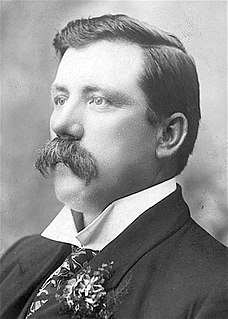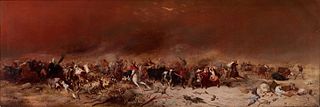
Sir Joseph Cook, was an Australian politician who served as the sixth Prime Minister of Australia, in office from 1913 to 1914. He was the leader of the Liberal Party from 1913 to 1917, after earlier serving as the leader of the Anti-Socialist Party from 1908 to 1909.
The Free Trade Party which was officially known as the Australian Free Trade and Liberal Association, also referred to as the Revenue Tariff Party in some states, was an Australian political party, formally organised in 1887 in New South Wales, in time for the 1887 colony election, which the party won. It advocated the abolition of protectionism, especially protective tariffs and other restrictions on trade, arguing that this would create greater prosperity for all. However, many members also advocated use of minimal tariffs for government revenue purposes only. Its most prominent leader was George Reid, who led the Reid Government as the fourth Prime Minister of Australia (1904–05). In New South Wales it was succeeded by the Liberal and Reform Association in 1902, and federally by the Anti-Socialist Party in 1906. In 1909, the Anti-Socialist Party merged with the Protectionist Party to form the Commonwealth Liberal Party.
The Protectionist Party or Liberal Protectionist Party was an Australian political party, formally organised from 1887 until 1909, with policies centred on protectionism. The party advocated protective tariffs, arguing it would allow Australian industry to grow and provide employment. It had its greatest strength in Victoria and in the rural areas of New South Wales. Its most prominent leaders were Sir Edmund Barton and Alfred Deakin, who were the first and second prime ministers of Australia.
The Liberal Party was a parliamentary party in Australian federal politics between 1909 and 1917. The party was founded under Alfred Deakin's leadership as a merger of the Protectionist Party and Anti-Socialist Party, an event known as the Fusion.

William Kidston was an Australian bookseller, politician and Premier of Queensland, from January 1906 to November 1907 and again from February 1908 to February 1911.
This is a list of the members of the Australian House of Representatives in the Fourth Australian Parliament, which was elected on 13 April 1910.

Sir Littleton Ernest Groom KCMG KC was an Australian politician. He held ministerial office under four prime ministers between 1905 and 1925, and subsequently served as Speaker of the House of Representatives from 1926 to 1929.

The 1906 Australian federal election was held in Australia on 12 December 1906. All 75 seats in the House of Representatives, and 18 of the 36 seats in the Senate were up for election. The incumbent Protectionist Party minority government led by Prime Minister Alfred Deakin retained government, despite winning the fewest House of Representatives votes and seats of the three parties. Parliamentary support was provided by the Labour Party led by Chris Watson, while the Anti-Socialist Party, led by George Reid, remained in opposition.

The 1910 Australian federal election was held in Australia on 13 April 1910. All 75 seats in the House of Representatives, and 18 of the 36 seats in the Senate were up for election. The incumbent Commonwealth Liberal Party led by Prime Minister Alfred Deakin was defeated by the opposition Labour Party, led by Andrew Fisher.

Selina Sarah Elizabeth Siggins was an Australian political activist who became the first woman to stand for the Australian House of Representatives. She ran as an independent at the 1903 federal election, the first at which women were eligible to be candidates. Although she spent most of her life in New South Wales, in 1918 she also became one of the first two women to stand for the Parliament of South Australia. Siggins was introduced to politics through her involvement in the labour movement, and initially supported the Labor Party. She eventually fell out with the party over its refusal to endorse her as a candidate. Her final run for parliament came at the 1922 federal election, where she became the first woman to stand for the Country Party.

John Thomson was an Australian politician. He was a Progressive Party member of the New South Wales Legislative Assembly from 1901 to 1904, representing the Manning electorate. He was then a member of the Australian House of Representatives from 1906 to 1919, representing Cowper for the Protectionist Party and its successors the Commonwealth Liberal Party and Nationalist Party.

Sydney Sampson was an Australian businessman and politician who served as a member of the House of Representatives from 1906 to 1919, representing the Division of Wimmera in Victoria. Outside of politics, he was a newspaper proprietor.
The Western Australian Party (WAP) was a short-lived Australian political party that operated in 1906. It was intended as a liberal party to protect the rights of Western Australians and to oppose the increasingly successful Labour Party, and drew its supporters from the Protectionist Party and the Anti-Socialist Party. John Forrest, a minister in Alfred Deakin's government, accepted the leadership of the party. Candidates were endorsed for all electorates in the 1906 federal election, including Forrest, but by the time of the election enthusiasm for the venture had diffused. The party elected Forrest in Swan and William Hedges in Fremantle. In practice they sat as independents and joined the Commonwealth Liberal Party when it formed.
This article provides information on candidates who stood for the 1906 Australian federal election. The election was held on 12 December 1906.
This article provides information on candidates who stood for the 1910 Australian federal election. The election was held on 13 April 1910.
This is a list of members of the Australian Senate from 1910 to 1913. Half of its members were elected at the 12 December 1906 election and had terms starting on 1 January 1907 and finishing on 30 June 1913—they had an extended term as a result of the 1906 referendum, which changed Senate terms to finish on 30 December, rather than 30 June—the other half were elected at the 13 April 1910 election and had terms starting on 1 July 1910 and finishing on 30 June 1916. Parties reflect those acknowledged at the time of the 1910 election.
This is a list of members of the Australian Senate from 1907 to 1910. Half of its members were elected at the 16 December 1903 election and had terms starting on 1 January 1904 and finishing on 30 June 1910; the other half were elected at the 12 December 1906 election and had terms starting on 1 January 1907 and finishing on 30 June 1913. They had an extended term as a result of the 1906 referendum, which changed Senate terms to finish on 30 June, rather than 31 December.

The history of the Australian Labor Party has its origins in the Labour parties founded in the 1890s in the Australian colonies prior to federation. Labor tradition ascribes the founding of Queensland Labour to a meeting of striking pastoral workers under a ghost gum tree in Barcaldine, Queensland in 1891. The Balmain, New South Wales branch of the party claims to be the oldest in Australia. Labour as a parliamentary party dates from 1891 in New South Wales and South Australia, 1893 in Queensland, and later in the other colonies.
The Tasmanian Liberal League was a political party in the Australian state of Tasmania. It was founded in 1909 and merged into the Nationalist Party in 1917. During its existence it formed a two-party system in the Parliament of Tasmania with the Australian Labor Party (ALP). Although the league was created in the same year as the federal Liberal Party, there were no formal ties between the two.









